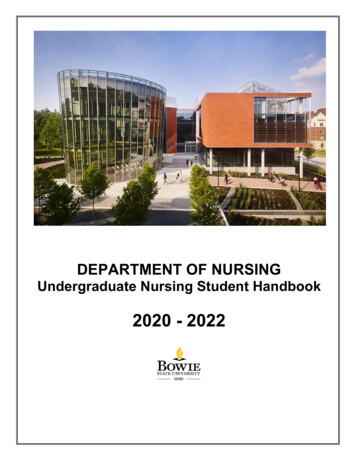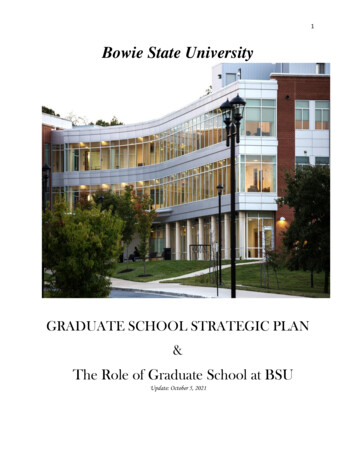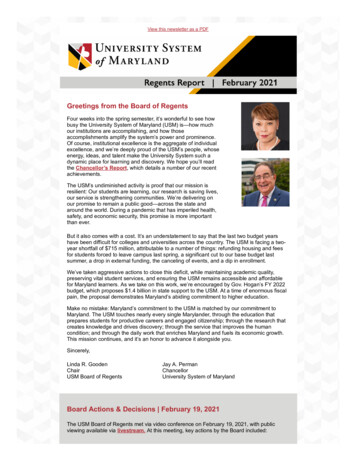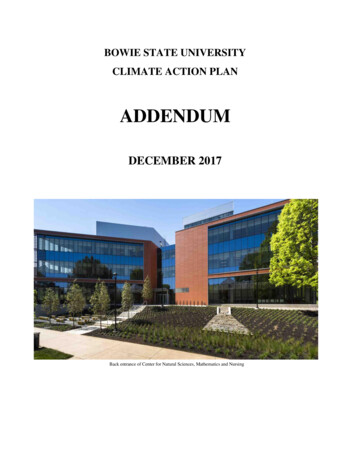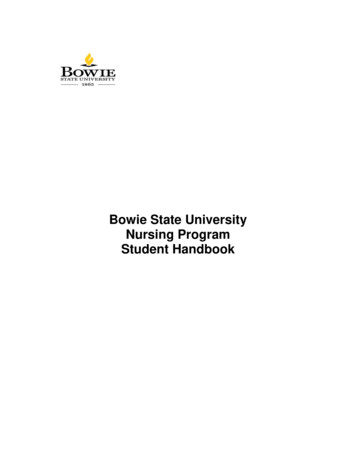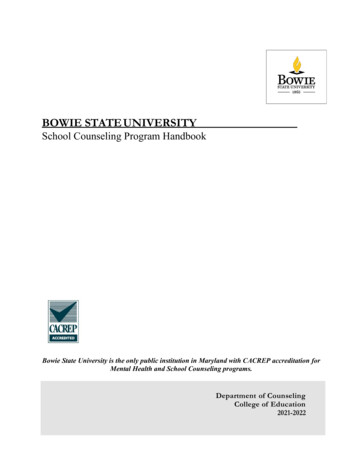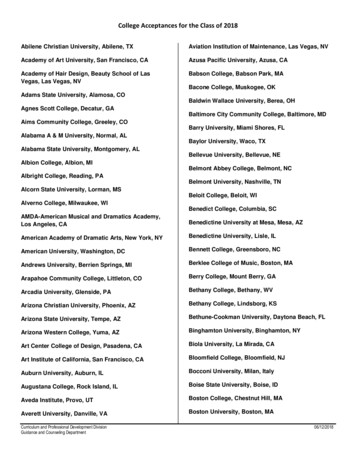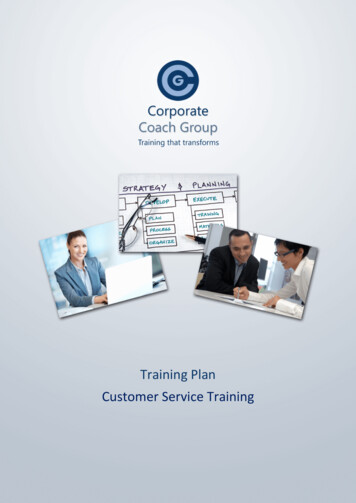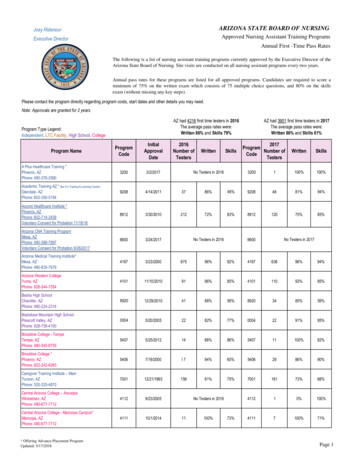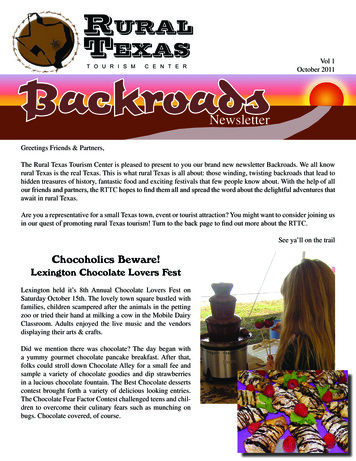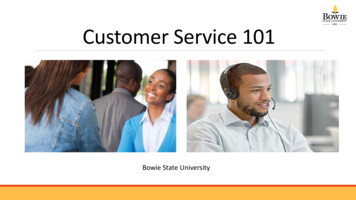
Transcription
Customer Service 101Bowie State University
Objectives Discuss how customer service looks atBSU Identify effective methods ofcommunication in customer service Recognize how to overcome commonchallenges in customer service Provide tips on how to improve customersatisfaction
“There is only one boss. The customer. Andhe can fire everybody in the company fromthe chairman on down, simply by spendinghis money somewhere else.”-Sam Walton
Customer Service at Bowie StateUniversity
Customer Service Complaints at BSU “I’ve been waiting forever” “I keep getting passed from one person toanother” “They don’t care” “They’re rude” “When I talk to someone, they don’t knowwhat they’re talking about” “I never hear back from them”
What Does Good Customer Service LookLike at BSU? “Treating people with a helpful, friendlyattitude” “Helping customers in a friendly manner” “Always being positive and willing to assistcustomers to the best of your ability” “Giving a good impression”
Understanding Our CustomersWe Need to Understand: Our customers’ demographics Our customers’ perceptions andexpectations The services and products we have tooffer Whether we have the capacity to meetour customers’ expectations. If not, what do we need to do to getthere?
Case Study: Chick-fil-A Known for it’s “Second Mile” approach tocustomer service Delivering food to tables with a smile Putting fresh flowers on the table Meeting customers in parking lots withumbrellas when it’s raining Always answering with “My Pleasurewhen a customer says thank
Communication in CustomerService
Methods of Communication Listening Speaking Writing Reading Non-verbal
ListeningA Good Listener: Conveys sincerity Focuses on the customer and what theyare saying Does not interrupt Listens with their eyes and their mindBad Listener: Formulating what they want to say whilethe customer is talking Thinking about other things while thecustomer is talking Jumping to conclusions
Speaking- Vocal QualityBe Mindful Of: Tone/Pitch Inflection Rate Volume
The Power of WordsSay .Avoid . How can I help you? What do you want? Consider this This is how it is I will find out There is nothing I can do I’ll be happy to That’s not my job
Effective Communication Open- ended questions Closed-ended questions
Open-Ended Questions Use if you need more than a “yes”, “no”,or one-word response Useful when you want general information Usually starts with the words what, how,or why
Closed-Ended Questions Use if you need a “yes”, “no”, or one-wordresponse Useful when you need specificinformation, to limit talking, or to controlthe direction of the conversation Usually starts with the words who, when,did, which, would, are, can, have, do, is,will, or may
Non-Verbal Body LanguageBe Mindful Of: Posture Feet and arms Hands Head and eyes
Telephone Customer Service Smile through the phone Answer with professional greeting Give answers and assistance as efficientlyas possible Thank the caller Conclude the call in a positive way
Telephone Etiquette Familiarize yourself with the features ofyour phone Answer in as few rings as possible Avoid side conversations Reduce background noise Never eat or drink while on the telephone Ask permission before placing someoneon hold Thank customer once he/she is off hold
How to Use Voicemail Effectively Identify yourself Speak slowly, clearly, and directly Keep it short Identify the type of response needed
Email Customer Service Proofread before sending Respond/answer promptly Avoid slang and acronyms Be careful with sensitive information Be clear and conciseUnderstand that email can be permanentand sent to anyone!
Face to Face Customer Service Smile Use a professional greeting Make eye contact Be aware of body language Give contact information for futurequestions Thank customer for coming in with theirinquiry
Customer Service Challenges
Barriers to Providing Good Customer Service Poor communication skills Staff not empowered to make decisions Lack of adequate training Polices that don’t make sense Poor leadership Unmotivated staff
Why Are Customers Challenging? They may not have an understanding orexpertise of the situation They may not speak our “language” They may have difficulty in makingdecisions They may be impatient, hostile, noncommunicative, immature, etc.
How to Work with Challenging Customers Listen and don’t interrupt Ask questions Show empathy Solve the problem Follow up End on a positive note
How to Handle a Very Difficult Customer Listen to their concerns Speak clearly and calmly Set limits Be clear that abusive or offensivelanguage/behavior will not be tolerated Consider involving a supervisor forassistance or a new perspective During phone calls, ask for a call backnumber and call back later This will allow the customer time tocool off
How to Handle a Very Difficult Customer During face to face interactions, directthem out of the lobby area to a place withless customers Reassure customer that you will follow up Don’t make promises that you cannotkeep Document the incident Understand what campus resources areavailable for further assistance
How to Communicate Bad News Acknowledge the customer’s feelings Share the responsibility of the problem Convey sincerity Ask for the opportunity to correct theproblem Request the opportunity to continue toserve them again in the future
What Happens When You Are Wrong? Admit your mistake Apologize for the error Find a solution Document the error Find ways to lessen the likelihood ofrepeated future error
Improving Customer Satisfaction
Evaluating Customer Service Staff Shadowing face to face contacts betweenstaff and customer Secret “shopper” Phone monitoring Evaluating email responses Conducting a knowledge assessment
Case Study: The Ritz Carlton HotelHow Does the Ritz Carlton measurecustomer satisfaction? Monthly computer-generated surveys aresent to recent guests Includes 30 questions with a rating scalefrom 1-10 “Guest Engagement Number” is the finalsum total of questions Goal is for number to continuously go up
Improving Customer Service Staff Coaching, counseling, and mentoring Leading by example
Assessing Customer Satisfaction LevelsEvaluating Your Customers Through: Surveys Interviews Focus groups Comment cards Suggestion boxes
Benchmarking Used as a self-improvement tool Comparing your organization to others Identify strengths and weaknesses andlearn how to improve Great way of finding and adopting bestpractices
Final Thoughts
Our Goal: Providing Good CustomerService at Every Interaction!Noticeable Benefits: Satisfied customers/students Increased retention Improved graduation rates Positive reputation and respect ofstudents, their families, and workcolleagues Personal fulfillment Resolution of problems
Resources r hereducation/ her-education-should-you-viewyour-jeff-wyatt-mba df/1701 PolicyPerspectives small.pdf ustomer-service/ gher-education http://customerservicezone.com/db/Customer research-brief.pdfService By Sector Or Industry/Education Sector/
Customer Service 101 Bowie State University. Objectives Discuss how customer service looks at BSU Identify effective methods of communication in customer service . Lack of adequate training Polices that don't make sense Poor leadership Unmotivated staff.
